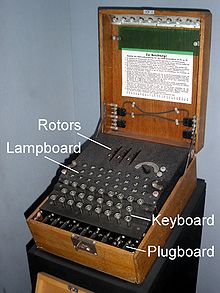From Wikipedia, the free encyclopedia
| The Enigma cipher machine |
|---|
German military texts encrypted using the Enigma machine were first broken by the Polish Cipher Bureau in December 1932. This success was a result of efforts by three Polish cryptologists Marian Rejewski, Jerzy Różycki and Henryk Zygalski, all working at the time for Polish military intelligence. They first 'reverse engineered' the device using theoretical mathematics, then built on this basis. This subsequently led to mechanical devices for breaking Enigma codes, called cryptologic bombs. This work was an essential part and substantial foundation to further work on decoding ciphers from constantly modernized Enigma machines, first in Poland, and after the outbreak of war in France and UK. Five weeks before the outbreak of World War II, on 25 July 1939, they presented their Enigma-decryption techniques and two full sets of decrypting equipment, including special cryptologic Zygalski sheets and cryptologic bomb together with "how to use" lecture by the team, to French and British military intelligence in Warsaw. Without this decision and gift from Polish military intelligence, decryption of German Enigma messages during World War II at Bletchley Park would not have been possible, as it was based on using mathematical theory and the perfecting of methods, tools and devices - all invented and developed beginning in 1932 by the mathematician-cryptologist team of Marian Rejewski, Jerzy Różycki and Henryk Zygalski.[3][4][5] From 1938 onwards, additional complexity was repeatedly added to the Enigma machines, making the initial decryption techniques increasingly unsuccessful. Nonetheless, the Polish breakthrough represented a vital basis for the later British continuation and effort.[6] During the war, British codebreakers were able to decrypt a vast number of messages that had been enciphered using the Enigma. The intelligence gleaned from this source, codenamed "Ultra" by the British, was a substantial aid to the Allied war effort.[7]
The exact influence of Ultra on the course of the war is debated; an oft-repeated assessment is that decryption of German ciphers hastened the end of the European war by two years.[8][9][10] Winston Churchill told the United Kingdom's King George VI after World War II: "It was thanks to Ultra that we won the war."[11]
Although Enigma had some cryptographic weaknesses, in practice, it was only in combination with procedural flaws, operator mistakes, laziness, neglect of the need to introduce systematic changes of encoding parameters, and capturing of key tables and hardware that Allied cryptanalysts were able to be so successful.[12]

No comments:
Post a Comment